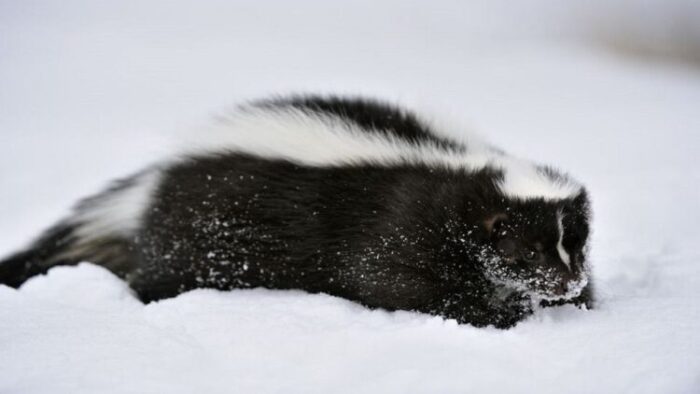Skunks are found across most of North and South America. In North America, the most common species are the striped skunk, spotted skunk, hooded skunk and hog-nosed skunk. When the cold winter months arrive, skunks have developed behavioral and physiological adaptations to survive. Unlike some mammals, skunks do not hibernate or migrate long distances. Instead, they have found ways to adapt to their environments. In this article we talk about Do Skunks Hibernate, Migrate or Adapt.
Table of Contents
Skunks Do Not Hibernate
Hibernation involves an animal going into a deep sleep state where their heart rate, body temperature and other metabolic functions decrease significantly. This allows them to conserve energy when food is scarce. Skunks, however, remain active year-round as they do not have large enough fat reserves or dense enough fur to enable hibernation. While skunks may sleep for longer periods during the winter, they periodically wake to search for food and water. Their body temperature and metabolism only drop slightly.
Being active in winter means skunks face increased energy demands in cold temperatures. To meet higher caloric needs, skunks spend more time foraging. They are opportunistic omnivores and consume a varied diet including insects, small mammals, eggs, berries and even garbage provided by humans. This winter diet allows them to build up winter fat reserves.
Skunks Seek Shelter Rather Than Migrate
Many species of mammals migrate long distances to escape harsh winter conditions. Migration allows them to follow available food sources and find more favorable climates. Skunks, however, do not make mass migrations. While some localized small-scale movements may occur, skunks mostly stay within their home ranges year-round.
Instead of migrating, skunks find shelter in unoccupied woodchuck or other small mammal burrows. They may also den in hollow logs, brush piles, abandoned buildings or crawl spaces under houses or porches. Choosing a sheltered den protects them from exposure to severe winter winds and precipitation. Inside the den, multiple skunks may congregate to take advantage of communal body heat.
Physiological and Behavioral Adaptations
In addition to seeking shelter, skunks have made other adaptations to survive cold winters. Their fur provides effective insulation, with two layers of fur protecting them from freezing temperatures. The dense underfur helps them conserve body heat.
Skunks also reduce their exposure through behavioral adaptations. They remain nocturnal but spend over 75% of winter nights inside their dens. Remaining inactive conserves energy. Skunks may even enter short-term torpor, which involves lowering their body temperature and metabolic rate for brief periods. Their winter daytime body temperature averages 5-10°F lower than during summer.
Another winter adaptation is delayed breeding. While skunks mate in late winter or early spring, fertilized eggs do not implant in the uterus until the following winter or spring. This ensures young are born during more favorable warmer conditions when food is more abundant.
Differences Between Species
The winter survival adaptations used may differ slightly across skunk species. The striped skunk is one of the most cold-tolerant species. Its thick luxurious winter fur and fat reserves allow it to remain active through harsh winters and survive in colder northern climates.
Spotted skunks have shorter, thinner fur and less fat accumulation. They rely more heavily on communal denning to share body heat. Due to their smaller size and lack of cold adaptation, spotted skunks are more restricted to relatively warmer southern climates.
Hog-nosed skunks have even more limited cold tolerance. They struggle in temperatures below freezing and are restricted to desert environments in the American southwest. They spend winter nights under insulation provided by logs, rocks or brush piles.
Hooded skunks in Mexico and Central America face less extreme winters and do not need to make special adaptations. They remain active year-round in their tropical habitats.
Threats During Winter Months
Despite their adaptations, winter remains challenging for skunks. Freezing temperatures, icy precipitation and deep snow can put them at risk. Food scarcity may lead to starvation or force them to take more risks while foraging.
Automobile collisions also increase as skunks venture out at night across snow-covered roads. Skunks may even wander onto frozen lakes or rivers, falling through thin ice. Exposure can be deadly as their wet fur loses insulating ability.
In suburban areas, skunks denning under buildings or porches increases the risk of encounters with humans and pets. They become more vulnerable if winter conditions force them to leave their shelter during daylight hours.
Conclusion
Skunks rely on a variety of behavioral and physiological adaptations to make it through harsh winters. Seeking shelter, opportunistic feeding habits, communal denning, fur insulation and short-term reductions in body temperature allow skunks to conserve energy when conditions are harshest. While skunks do not hibernate or migrate long distances, their adaptations provide the ability to survive and even remain active year-round in many areas they inhabit. Care should still be taken to protect and coexist safely with these unique mammals during the vulnerable winter season. I sincerely hope you find this “Do Skunks Hibernate, Migrate or Adapt?” article helpful.

With over 5+ years of experience in pest control and a PhD in Entomology, our author brings a blend of scientific knowledge and practical expertise to Pestifier.com. Passionate about creating pest-free environments, they provide effective tips and strategies for managing and preventing pest infestations. Connect on Facebook for the latest updates and insights.

